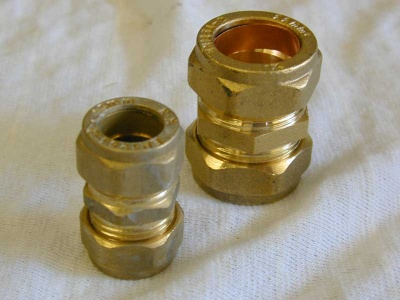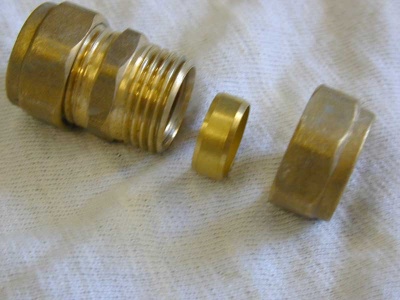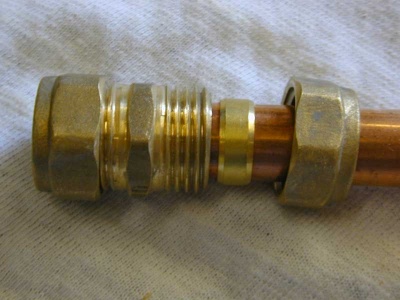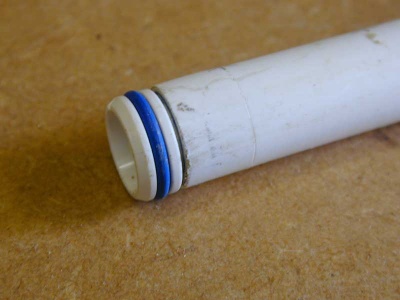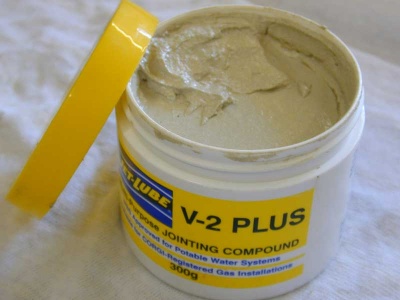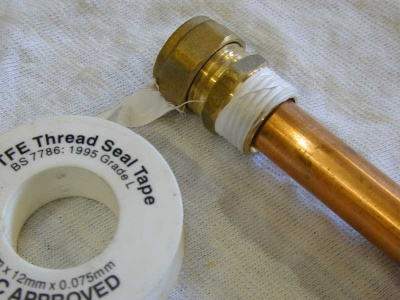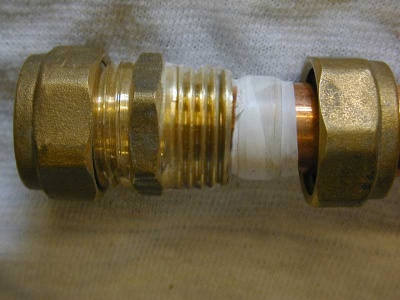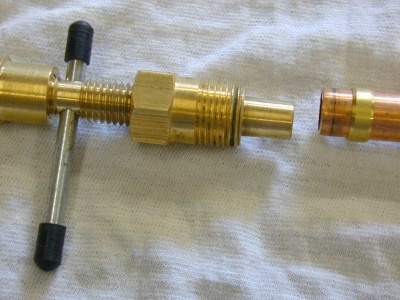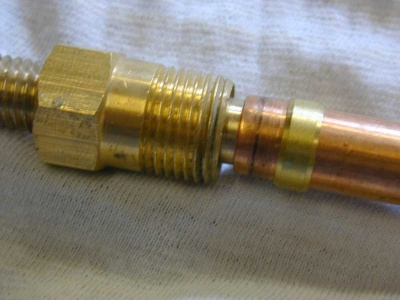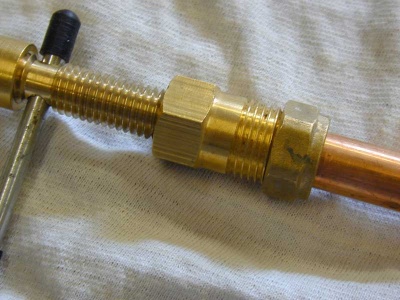Compression fitting
Compression plumbing fittings are fairly easy to fit, and make a secure joint. They're also fairly straightforward to remove later and require no soldering skills. Hence they're popular.
Pros:
- No heat or soldering required
- Mechanically strong joint
- Can be used on wet and dripping pipes
- Safe on gas and water
- Work at high temperatures where soft solder would fail
Cons:
- Expensive
- Ugly
- Physically large and lumpy
Components
Compression fittings are usually made with brass main body, backnuts, and a copper or brass olive. The main body has a recess into which the pipe is slid, and the compression backnut then drives the compression olive into the gap between the pipe surface and the joint's body casting.
The components can be assembled onto the pipe separately, or in many cases the whole fitting with the olive and loosened backnut simply slid onto the pipe complete.
Use
Compression joints are designed to be used without any sealant. The nut compresses the olive driving it into the cone shaped profile at the end of the fitting body, causing deformation of both the metal surfaces of the olive and the pipe, zeroing the gap and creating a watertight seal.
Once the nuts are done up hand tight on the joint, and additional half turn with a pair of spanners (one on the body of the fitting to hold it still, the other on the nut) is usually adequate to make a seal. If the joint leaks, and additional tightening tweak will normally fix it. Note that over-tightening a joint may actually make it leak.
Copper and brass olives both work fine on copper pipe. Olives can't be removed from a pipe and reused. Even hand tightening a fitting with an olive inside before the pipe is inserted, is enough to make the olive unusable.
You can usually dismantle and remake a sound compression joints without ill effect. However if you attempt to reuse an already fitted olive in a new fitting body (say changing a radiator valve but keeping the existing olive and back nut on the pipe tail), results can be variable since the depth of penetration of the pipe into the fitting is not standardised. If the protruding length of pipe beyond the olive is too long for the new fitting, no amount of tightening will make a sound joint.
When remaking a joint where the old olive is stuck firmly to the pipe, you may be able to trim the end of the pipe down if that is what is preventing the olive from sealing. However if the problem is just incompatibility of the mating surfaces, you will either have to cut the end of the pipe off and start afresh, or try one of the sealing techniques shown below.
Metal
Copper pipe works well with compression fittings. Chrome plated copper pipe also works well. Some advocate stripping the chrome from the area of the pipe in the fitting as this allows the olive to get a better grip on the pipe. There is no actual need to do this, but if not doing so, it is advisable to torque the nuts a little higher than with normal copper pipe since its harder for the olive to "bite" the chromed pipe.
Preparation
The pipe needs to be cut square and cleanly, with any burrs removed. Pipes cut with a pipe cutter are much easier to use than those cut with a saw. The pipe needs to be clean and free from contaminants like paint or plaster etc. It does not need to be quite as clean and shiny as required for soldered connections.
Plastic
Plastic pipe can be joined with compression fittings, however it is important to use the correct brand of pipe insert to support the end of the pipe, or else the joint may start to leak over time.
Speedfit insert used on speedfit 15mm pipe
Preparation
Again, a clean square cut is important, and any burrs removed. Take great care to protect pipe ends when pulling them under floors etc, since its very easy to scratch plastic pipe and this makes it hard to get a good compression (or pushfit for that matter) seal.
Sealing techniques
New fittings used on fresh pipe should seal with a close to 100% success rate if made properly. However sometimes you will get a joint that will not seal perfectly. This can be for any number of reasons including scratches and nicks to any of the metal mating surfaces.
Sometimes tightening fittings in confined spaces can be difficult - and inadequate tightening will result in a leaking joint. Lubricating the threads of the joint can help by making it easier to tighten the backnut{s}. There are two common ways to do this. One is to add a jointing compound to the threads:
The other way is to use a few turns of PTFE tape to the threads. Note that used this way the PTFE will not aid the sealing of the joint, but it will make the nuts easier to torque up.
If the problem with the joint is not lack of torque, one will need to coat the mating surfaces with sealant before assembling & tightening. Opinions tend to polarise over whether one should do this never, sometimes or always. When even this is liable to not seal, e.g. when the pipe is visibly deformed or damaged, packing the nut with sealant as well can make it work. This forces sealant over and into the joint as the nut is tightened - the sealant left behind in the nut does nothing to create a seal.
PTFE tape can also be used as a sealant - a few turns need to be wound over the olive such that they will end up sat between the mating surface between the olive and the fitting:
Use of PTFE tape on both olive and threads can be of course be combined to both lubricate and seal.
Note that this may not cure a leak that is caused by a scratch on the pipe under the olive. You may be able to wind a couple of turns under the olive - but this is less easy.
Non setting lubricants and jointing compounds like that shown above can also be applied under and over the olive. This can be more effective for fixing leaks due to pipe scratches.
The most effective "cure all" sealants are the silicone based "setting" sealants like Fernox LS-X. These will usually seal most problem joints so long as the olive is actually meeting the fitting body when the nut is tightened.
Note that any sealants used on drinking water must be approved for this use.
Removing an olive
Sometimes it is necessary to remove an olive from a pipe - wither because its damaged and a new one is required to make a working seal, or because it is holding a backnut captive.
Care must be taken to not damage a pipe when removing the olive.
Olive puller
The best way to remove an olive is with a purpose made olive puller. These are normally simple threaded devices that use the captive backnut itself to pull the olive form the pipe:
First the nose of the puller is inserted into the open end of the pipe
Then the nut is engaged with the thread on the puller
Finally the tee bar on the puller is used to draw the outer sleeve of the puller (and hence the backnut threaded onto it) up the pipe pulling the olive free.
Adjustable spanner
Sometimes an olive can be removed by tightening an adjustable spanner closely around the pipe, and then using it as a slide hammer to strike the nut or the olive itself and drive it toward the pipe end.
Hacksaw
Another technique is to cut most of the way through the olive at a 45 degree angle to the pipe (doing it at an angle makes it far less likely that you will damage the pipe). Once you have a slot in the olive, insert a normal screwdriver into the slot and turn. This will split the olive at the partial cut, hopefully leaving the pipe undamaged.
